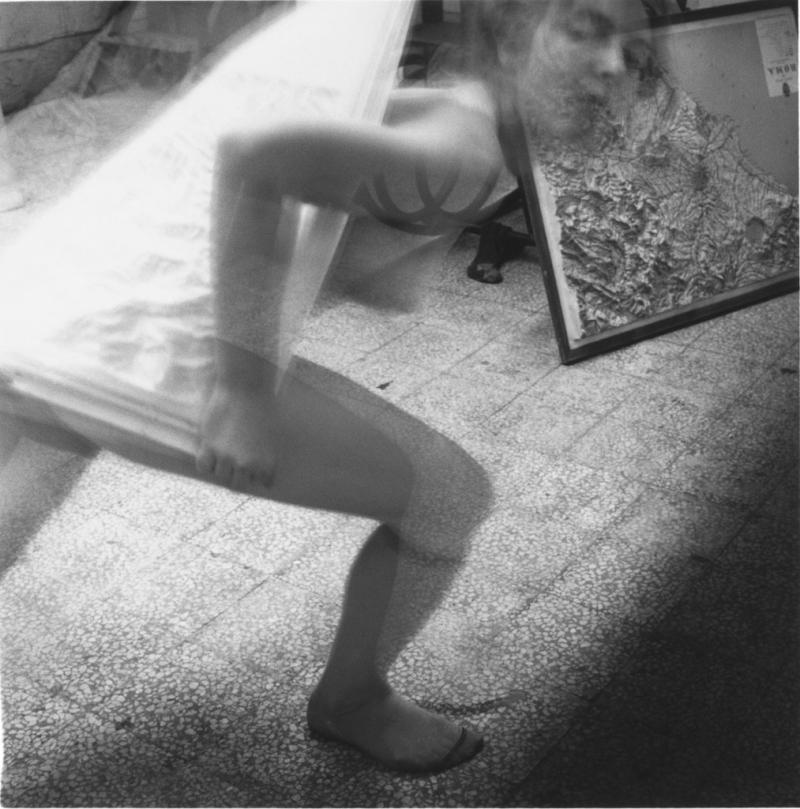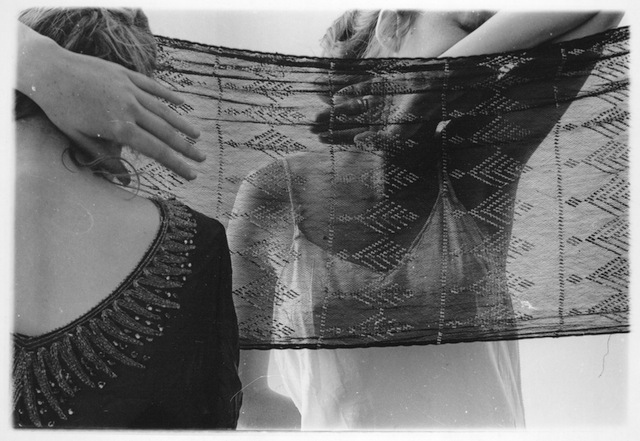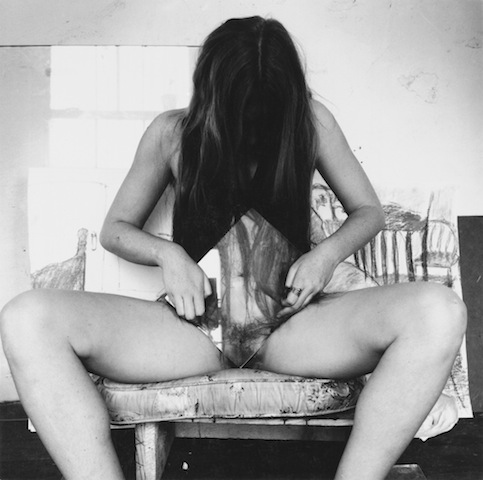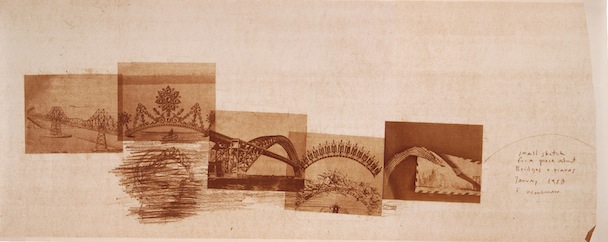Francesca Woodman: Zigzag, Victoria Miro | reviews, news & interviews
Francesca Woodman: Zigzag, Victoria Miro
Francesca Woodman: Zigzag, Victoria Miro
An exhibition that lends new insights and depth to the late photographer's work

Francesca Woodman killed herself at the age of 22, the biographical fact that colours her work and which it is de riguer to mention. She left behind paintings, it is said, as yet publicly unseen, and literally hundreds upon hundreds of negatives and 800 proofs of black and white pre-digital photography.
She was born in 1958 in Denver to artist parents George and Betty Woodman and spent her childhood in Colorado. But the family also spent substantial time in Florence, and many a summer thereafter in their own house in the Tuscan countryside. Francesca went for a year or so to an American equivalent of Eton (Phillips Academy), then Rhode Island School of Design, and was already exhibiting in well known galleries before her death. An international network of leading commercial galleries and public museums now show her work. (Pictured below: untitled, New York, 1979-80.)
 The short life was packed with geographical incident and a subtly invidious kind of energy. Much of her photography required almost heroic kinds of physical endeavour, with cameras on the ceiling and a variety in scale. Her main subject is herself, as she put it, always available, where she features in an interior or a wistful landscape. The imagery is non-narrative, except that she intriguingly suggests some kind of story going on beyond the frame of the photograph. It exhibits the kind of self-obsessed poignancy that, say, Duane Michals has made his own, the yearning that infects say Robert Mapplethorpe’s self examination. Mirror, mirror on the wall, who is the fairest of them all: in this case the mirror is the camera.
The short life was packed with geographical incident and a subtly invidious kind of energy. Much of her photography required almost heroic kinds of physical endeavour, with cameras on the ceiling and a variety in scale. Her main subject is herself, as she put it, always available, where she features in an interior or a wistful landscape. The imagery is non-narrative, except that she intriguingly suggests some kind of story going on beyond the frame of the photograph. It exhibits the kind of self-obsessed poignancy that, say, Duane Michals has made his own, the yearning that infects say Robert Mapplethorpe’s self examination. Mirror, mirror on the wall, who is the fairest of them all: in this case the mirror is the camera.
Her significance is perhaps partly explained not only by the unprecedented growth of self-absorption, narcissistic yes, but also questioning and even despairing, which is the tenor of our times; the current craze for the selfie at one level, and the continuing search for satisfying relationships with the self – and others – which seems to define our notion of the have-it-all society. That Francesca Woodman was also a beautiful young woman who, however self-consciously, made her own self her chief subject is hardly a disadvantage. It is unclear whether it is deliberate that some of the poses curiously echo the Lautrec and especially Dégas scenes of naked women, prostitutes and brothels, and perhaps especially some of the photographs of the prostitutes of the New Orleans district of Storyville, their wares on display, by the turn of the last century photographer EJ Bellocq. Here in the parlance of feminism women were subjected to the male, even at times misogynist, gaze. (Pictured below: Providence Road Island, 1976)
 In Zigzag, though, this compilation does something which gives added depth to Woodman’s images. Yes, there are the usual subjects, Woodman herself and occasionally her female peers also pressed to join her in an unclothed state (and in our airbrushed universe, it is rather unexpected to see unabashed pubic and armpit hair casually displayed, let alone some curiously innocent self examinations). But as the exhibition title indicates the selection underlines the careful almost geometric structure that underlines the seemingly artless, spontaneous groupings of adolescent or twenty-somethings languidly flinging themselves about in contradictory fashion.
In Zigzag, though, this compilation does something which gives added depth to Woodman’s images. Yes, there are the usual subjects, Woodman herself and occasionally her female peers also pressed to join her in an unclothed state (and in our airbrushed universe, it is rather unexpected to see unabashed pubic and armpit hair casually displayed, let alone some curiously innocent self examinations). But as the exhibition title indicates the selection underlines the careful almost geometric structure that underlines the seemingly artless, spontaneous groupings of adolescent or twenty-somethings languidly flinging themselves about in contradictory fashion.
Her father George, one half of the parental guardian of the flame, suggests, of course accurately, that the 1970s were the time of the grid, calling on Mondrian, Judd and Jasper Johns, although curiously not mentioning that king of the line, Sol LeWitt.
There is a quiet wit: a small piece of five joined images on bridges and tiaras, described as a sketch (pictured below). A linking too called Zigzag Study, New York, of some 13 images of female bodies, limbs, dress collars, all zig-zags, which has a gently subversive humour. You start spotting the zig-zags, arms and legs bent at elbow and knee, in all the other haunting images of Francesca, it turns out, at play. This transforms our sense of the anxiety which has hitherto appeared to infuse most of her photographs, so often seemed to be hinting at a catastrophe just about to happen. This small exhibition, by concentrating on a semi-hidden motif, makes her both a more approachable and more considerable artist than hitherto. 
What would have happened is a mystery of course. Had she already peaked? Are these works frozen in aspic, or would going on have led to liberation, an even greater invention, and an imagination which looked to embrace an ever wider world?
Explore topics
Share this article
The future of Arts Journalism
You can stop theartsdesk.com closing!
We urgently need financing to survive. Our fundraising drive has thus far raised £49,000 but we need to reach £100,000 or we will be forced to close. Please contribute here: https://gofund.me/c3f6033d
And if you can forward this information to anyone who might assist, we’d be grateful.

Subscribe to theartsdesk.com
Thank you for continuing to read our work on theartsdesk.com. For unlimited access to every article in its entirety, including our archive of more than 15,000 pieces, we're asking for £5 per month or £40 per year. We feel it's a very good deal, and hope you do too.
To take a subscription now simply click here.
And if you're looking for that extra gift for a friend or family member, why not treat them to a theartsdesk.com gift subscription?
more Visual arts
 'We are bowled over!' Thank you for your messages of love and support
Much-appreciated words of commendation from readers and the cultural community
'We are bowled over!' Thank you for your messages of love and support
Much-appreciated words of commendation from readers and the cultural community
 Folkestone Triennial 2025 - landscape, seascape, art lovers' escape
Locally rooted festival brings home many but not all global concerns
Folkestone Triennial 2025 - landscape, seascape, art lovers' escape
Locally rooted festival brings home many but not all global concerns
 Sir Brian Clarke (1953-2025) - a personal tribute
Remembering an artist with a gift for the transcendent
Sir Brian Clarke (1953-2025) - a personal tribute
Remembering an artist with a gift for the transcendent
 Emily Kam Kngwarray, Tate Modern review - glimpses of another world
Pictures that are an affirmation of belonging
Emily Kam Kngwarray, Tate Modern review - glimpses of another world
Pictures that are an affirmation of belonging
 Kiefer / Van Gogh, Royal Academy review - a pairing of opposites
Small scale intensity meets large scale melodrama
Kiefer / Van Gogh, Royal Academy review - a pairing of opposites
Small scale intensity meets large scale melodrama
 Jenny Saville: The Anatomy of Painting, National Portrait Gallery review - a protégé losing her way
A brilliant painter in search of a worthwhile subject
Jenny Saville: The Anatomy of Painting, National Portrait Gallery review - a protégé losing her way
A brilliant painter in search of a worthwhile subject
 Abstract Erotic, Courtauld Gallery review - sculpture that is sensuous, funny and subversive
Testing the boundaries of good taste, and winning
Abstract Erotic, Courtauld Gallery review - sculpture that is sensuous, funny and subversive
Testing the boundaries of good taste, and winning
 Edward Burra, Tate Britain review - watercolour made mainstream
Social satire with a nasty bite
Edward Burra, Tate Britain review - watercolour made mainstream
Social satire with a nasty bite
 Ithell Colquhoun, Tate Britain review - revelations of a weird and wonderful world
Emanations from the unconscious
Ithell Colquhoun, Tate Britain review - revelations of a weird and wonderful world
Emanations from the unconscious
 Rachel Jones: Gated Canyons, Dulwich Picture Gallery review - teeth with a real bite
Mouths have never looked so good
Rachel Jones: Gated Canyons, Dulwich Picture Gallery review - teeth with a real bite
Mouths have never looked so good
 Yoshitomo Nara, Hayward Gallery review - sickeningly cute kids
How to make millions out of kitsch
Yoshitomo Nara, Hayward Gallery review - sickeningly cute kids
How to make millions out of kitsch
 Hamad Butt: Apprehensions, Whitechapel Gallery review - cool, calm and potentially lethal
The YBA who didn’t have time to become a household name
Hamad Butt: Apprehensions, Whitechapel Gallery review - cool, calm and potentially lethal
The YBA who didn’t have time to become a household name

Add comment